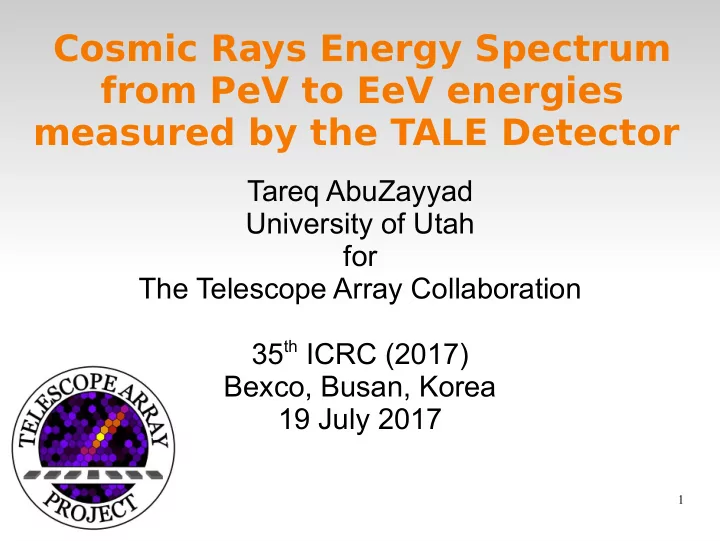

Cosmic Rays Energy Spectrum from PeV to EeV energies measured by the TALE Detector Tareq AbuZayyad University of Utah for The Telescope Array Collaboration 35 th ICRC (2017) Bexco, Busan, Korea 19 July 2017 1
Outline ● TA L ow E nergy extension (TALE) Fluorescence Detector (FD). ● Spectrum Data Set. ● Spectrum / Aperture Calculation ● Energy Spectrum ● Summary. 2
TA Low Energy Extension (TALE) 10 new telescopes to look higher in the sky (31-59 o ) to see shower development Infjll surface detector array to much lower energies of more densely packed surface detectors (lower energy threshold)
TALE FD Telescopes / Camera
Middle Drum TA/TALE Viewing Range ● TAMD + TALE ● 14 lower pointing telescopes make up TA (Middle Drum) Detector. ● 10 higher pointing telescopes make up the TA- Low Energy extension Fluorescence Detector (Rings 3 & 4). ● TALE telescopes equipped with (HiRes2) FADC electronics. 5
Track-like Cherenkov Event A Cherenkov event seen in two TALE telescopes 6
TALE FD Data collection period TALE FD data collected from 06/20/2014 to 03/31/2016 ( 22 months ) is used. Only good weather data: Good weather selection “clear overhead” + “no haze” A comparison of event data rates vs. MC expectation is used to determine periods of significant attenuation due to haze. Total on-time 1080.0 hours. 7
Data Division (Event energy/type) Once an observed event is reconstructed it can be placed into one of three subsets: Cherenkov dominated events (C'kov > 75% of total) Fluorescence dominated events (Scin. > 75% of total) Mixed signal events (All other events). The three subsets span different but overlapping energy ranges. Different, appropriate, event selection criteria (quality cuts) are applied to each set. A combined set is used to measure the energy spectrum. 8
Event subsets 9
Spectrum Calculation Aperture Calculation (Simulation): Shower library created with CONEX and QGSJetII-03 Mixed Composition following the H4a model ... Alternative: Fit to observed xmax distributions. Detector simulation: Hourly atmospheric profile ( GDAS). Actual Mirror live-times (for each data part) Nightly PMT Gains from DB ( UVLED data collected at the start of the run ) Average Sky Noise background (no time dependence.) Average Aerosols. Event reconstruction: Monocular (profile constrained fit) Nightly gain calibration. 10
Aperture Calculation (Composition Dependence) Performing Data / MC comparisons, it was found that the MC (H4a, QGSJetII-03) x max distributions are not in good agreement with the data (for most energies). To achieve agreement, we modified the composition (fractions of different primaries) in the MC. For Each Energy Bin: Fit the x max distribution to four independent components: pr , he , cno , and fe . Note that the resulting primary fractions (composition) depends on our choice of hadronic interaction model. 11
Aperture Calculation (Composition Dependence) A change in the composition assumption can affect the spectrum in two ways: Affects aperture estimation (especially at E < ~10 16 eV) Affects event energy assignment (E cal → E tot ); different missing energy correction for different primaries. Combined effect will be a change in the overall normalization. 12
Example Fit Result Example xmax dist. Fit. E cal 10 16.5 -10 16.6 eV Black points: TALE data. Magenta points: H4a MC (QGSJetII-03) Red histogram: Fit to data. 13
Data/MC before and after fjt 14
Energy Spectrum (1) Using fits to TALE x max distributions Spectral breaks: slopes before/after and energy are indicated on the figure. Errors are statistical errors from fitting routine. 15
Energy Spectrum(2) Effect of changing composition assumption. GST composition by re-weighting H4a MC. 16
Energy Spectrum (3) Comparison to other experiments. 17
Energy Spectrum (4) Comparison to other experiments. Connection to UHECR (TA SD Energy Spectrum) 18
Summary We presented a measurement of the cosmic rays energy spectrum using data from TALE FD. We made use of TALE measured x max distributions to infer a model independent input composition for aperture calculation and event missing energy assignment. The measured spectrum spans the energy range from 10 15.4 – 10 18.4 eV, using a combined set of Cherenkov/Fluorescence and mixed signal events. Two features are observed: a hardening of the spectrum at an energy of ~10 16.25 eV. a steepening of the spectrum at an energy of ~10 17.05 eV. 19
Backup Slides 20
TALE Event Reconstruction Event reconstruction entails reconstructing: Shower geometry Shower profile/energy. Cerenkov events are reconstructed as monocular events. Profile constrained Geometry Fit (PCGF) method (developed and used for the HiRes-I analysis) is adapted for TALE: Unlike for HiRes-I, the shower xmax parameter is fixed only at the start of the fit but is turned into a free fit parameter at a later step in the reconstruction process. 21
TALE FD Exposure ~10 17 eV threshold for air fluorescence detection. ~10 18 eV the fact only high elevation view results in smaller aperture gain. 22
Recommend
More recommend